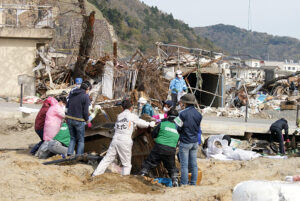Opinion
Actions for Relief of Victims of the East Japan Great Earthquake, Tsunami and Fukushima Daiichi Nuclear Plant Accident

On March 11, 2011, at 2:46 p.m., a big earthquake of magnitude 9.0 on Richter scale, followed by a gigantic tidal wave or tsunami, hit vast areas in East Japan. It caused a tremendous damage: 15,846 people died while 3,317 others are still reported missing (figures provided by the government on February 8, 2012). Huge tsunami that rushed to the Pacific coast of the Main Island (Honshu) utterly destroyed and washed away many towns and villages, claiming a large number of human lives. The disaster also took away from those who narrowly escaped death their houses, their jobs and their peaceful day-to-day life with all the fond memories.
All this was followed by a severe nuclear accident at the Fukushima Daiichi Nuclear Power Plant, later rated “level 7” like Chernobyl accident,. People living around the plant had to evacuate the area leaving their homes behind. Even today, nearly 100,000 citizens of Fukushima Prefecture are still forced to live in shelters within or outside the prefecture.
According to the Ministry of Education, Science and Technology (MEXT), the earthquake also had considerable impacts on children and schools: 641 pupils, teachers and school staff died, including 494 children, teachers and other employees in the primary and secondary schools and 92 others who are still missing.
In addition, 12,150 schools suffered damage on the school buildings. As of October 1, 2011, of all the public schools in the three disaster-stricken prefectures of Iwate, Fukushima and Miyagi, 106 had to use other schools’ buildings and/or other facilities to continue education activities. As far as schools and education activities are concerned, the efforts for complete recovery and restoration have just begun.
Zenkyo, immediately after the earthquake disaster on March 14, set up the Headquarters for East Japan Great Earthquake (later joined by the Liaison of Teachers’ and Staff’s Unions) and has organized fundraising, collection and distribution of food and other supplies and recruited and sent volunteers to help the sufferers in the disaster-stricken regions.
As a result, Zenkyo collected 66 million yen of donations by the end December 2011. Most part of this money was given to the local education boards of the three prefectures and 34 municipalities. It will be used for establishing a special scholarship fund of municipal employees’ and education workers’ unions, so that the donations will be utilized for providing direct assistance to children.
Volunteer relief operations, organized on three occasions in May, July and August in the areas around Ishinomaki City, Miyagi Prefecture. 2,000 teachers and school employees in total, coming from all over the country, took part in these operations that consisted of removing heaps of rubbles, restoration of oyster aquaculture facilities, cleaning of cemeteries, assistance to refugees accommodated in prefab shelters etc.
The accident in Fukushima Daiichi Power Plant deprived the people living around it of everything they needed to live. Entire towns and villages had to move to elsewhere considered “safe” from radiation. For those who had no choice but to remain, the fear of radiation contamination of children and other vulnerable family members is putting a considerable physical and mental stress. Zenkyo has issued a series of “Recommendations for Protecting Children from Radiation Contamination and Damage” and petitioned the National Government, political parties and MPs to take these recommendations in to account. It also calls on local education boards and parents and teachers associations to have consultation on these proposals.
As children in Fukushima Prefecture are saying they want to “take a deep breath without any fear”, we call on teachers’ and staff’s unions around the country to host Fukushima children’s stay in their communities during summer vacation.
These initiatives help to increase Zenkyo’s visibility among teachers who are now becoming more supportive and more trustful to Zenkyo’s actions. This is reflected in the fact that some young teachers who participated in Zenkyo’s volunteer relief operations later came to join the union.
